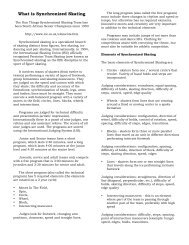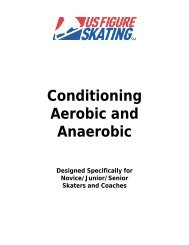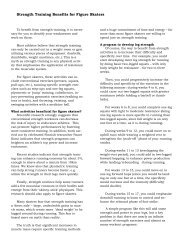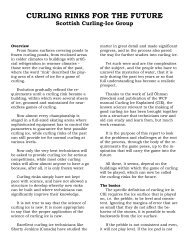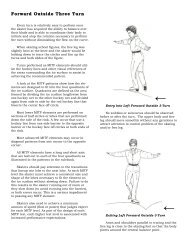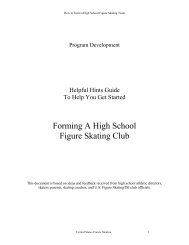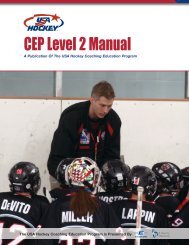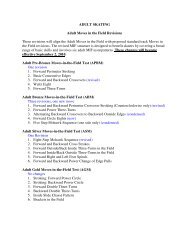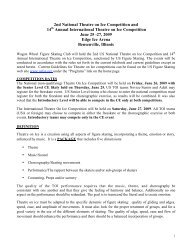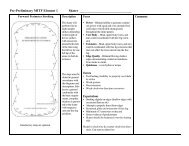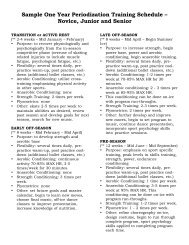CEP Level 3 Manual - Rushmore Hockey Association
CEP Level 3 Manual - Rushmore Hockey Association
CEP Level 3 Manual - Rushmore Hockey Association
Create successful ePaper yourself
Turn your PDF publications into a flip-book with our unique Google optimized e-Paper software.
T A B L E O F C O N T E N T SStrength and SizeAfter a body part has been immobilized (cast,splint wrap or disuse), muscles become smallerand weaker than they were prior to the injury. Justbecause a cast is removed and the injuries have“healed” does not mean that players are ready topractice or play at full speed. Loss of muscle massmeans a loss of strength. Letting the player resumea normal practice schedule before strength hasreturned to pre-injury levels could lead to re-injury.Strengthening the injured area should be done veryconservatively. If weights are used, start with lightweights and perform the exercise through the entirerange of motion. If the exercise causes pain, thenlighter weights should be used. Your goal is to havethe players regain full strength through the entirerange of motion before allowing them to return tocompetition. To determine when full strength andsize has been regained, compare the injured area tothe non-injured area on the opposite side of thebody. When both areas are of equal size andstrength then the players may progress to the nextphase of recovery.Normal Speed and AgilityIf the lower parts of the body were injured,skating drills which incorporate progressively moreintense changes of speed, and/or direction,stopping and accelerating will provide a goodindication of the player’s recovery. If the upper partof the body was injured, passing and shooting drillsshould be attempted also. In your observation ofinjured players, try to detect any favoring of theinjury or inability to smoothly perform a skill atincreasing intensities. When players can move atpre-injury speed and agility, they are almost readyto play.The main goal of a rehabilitation program is tore-establish range of motion, strength, power andmuscular endurance to the injured area<strong>Level</strong> of FitnessEvery extended layoff reduces the level ofmuscular fitness. While recovering, the player maybe able to exercise other body parts withoutaffecting the injured area. Someone with a sprainedankle may not be able to skate, but may be able toswim. Someone with a broken wrist may be able tojog or ride a bike. Encourage this type of activity,because it helps to maintain portions of their preinjurylevels of fitness. Players who have missedlong periods of time due to an injury, shouldpractice for several days after meeting the previouscriteria, before being allowed to play in a game.Their cardiovascular system and the endurance ofthe injured musculature need time to adjust to thedemands of the game. The longer the layoff, themore conditioning work they will need.SUMMARYThis chapter was an attempt to acquaint youwith various injuries associated with hockey andhow you should be prepared to deal with theseinjuries. If you have prepared your first aid kit,brought along the medical records and familiarizedyourself with the different types of injuries, youshould be able to handle whatever situation arises.Follow the steps that are outlined for you andremember – you are not a doctor. If you are indoubt about how to proceed, use the coins in yourfirst aid kit and call for professional help. Do notmake decisions about treatments if you are notqualified to make them.Remember, react quickly and with confidence.Most injuries will be minor and the injured playerswill need only a little reassurance before they can bemoved to the bench area. Injuries will always occurin ice hockey. Therefore, you must prepare yourselfto deal with whatever happens in a calm,responsible manner.When the pain is gone, and the range of motion,strength, agility and conditioning are back tonormal, your player is ready to resume play. Theentire process may take two days for a bruise to 12weeks or more for a fracture. In either case, if youhave followed the general guidelines of this chapter,you know you have acted in the best long-terminterest of the player. Participation is important, butonly if the participation is achieved with a healthybody. Resist the pressure and the temptation to rushplayers into a game before they are ready. Yourpatience will be rewarded in terms of the long termhealth and performance of your players. Name: ___________________________________________________Phone: _____________________Address: _________________________________________________________________________________Physician’s Name: ________________________________________Phone: _____________________Hospital of Choice: ________________________________________________________________________ If the answer to any of the following questions is yes, please describe the problem and its implicationsfor proper first aid treatment on the back of this form.❑ Head Injury ❑ Fainting spells❑ Convulsions/epilepsy❑ Neck or back injury + '"3+*."*/ + -"/"!& ( &./+-3 +-)This is to certify that on this date, I __________________________________________, as parent orguardian of __________________________________________, (athlete participant), or for myself as anadult participant, give my consent to USA <strong>Hockey</strong> and its medical representative to obtain medicalcare from any licensed physician, hospital, or clinic for the above mentioned participant, for any injurythat could arise from participation in USA <strong>Hockey</strong> sanctioned events.If said participant is covered by any insurance company, please complete the following:Insurance Company: ___________________________________________________________Policy Number: _______________________________________________________________-"*/0-!&*!0(/ -/& &,*/ &$*/0-" ❑ Asthma❑ High blood pressure❑ Kidney problems❑ Hernia❑ Heart murmur1" 3+0 %! +- !+ 3+0 0--"*/(3 %1" *3 +# /%" #+((+2&*$Have you had a recent tetanus booster? ❑ Yes ❑ No If yes, when? _________________________Are you currently taking any medications? ❑ Yes/" Excess accident insurance up to $25,000, subject to deductibles, exclusions and certain limitations,is provided to all USA <strong>Hockey</strong> registered team participants. For further details visit usahockey.com orcontact USA <strong>Hockey</strong> at (719) 576-USAH. ❑ Allergies _________________❑ Diabetes❑ Other ______________________________________________________________________❑ No If yes, please list all medications on back.Has a doctor placed any restrictions on your activity? ❑ Yes ❑ No If yes, please explain on back. "1 74 | USA <strong>Hockey</strong> Coaching Education Program <strong>Level</strong> 3 <strong>Manual</strong>Risk Management | 75



